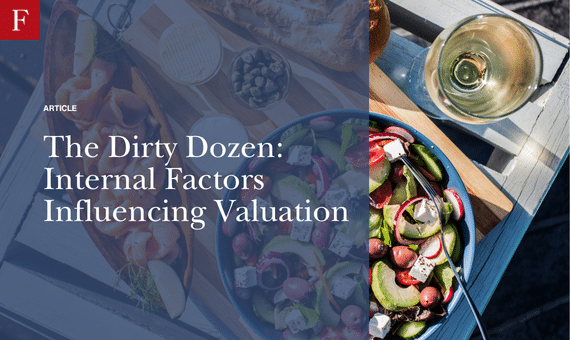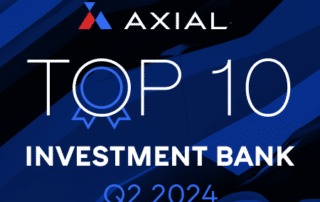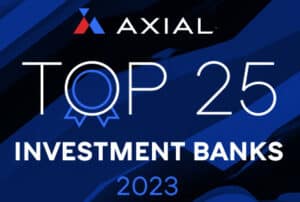
The Dirty Dozen: Internal Factors Influencing Valuation
Valuations are heavily dependent on external market/economic driven factors, such as interest rates, consumer sentiment, and the geopolitical landscape. Those factors are beyond the control of leaders of private companies. However, there are many internal factors leaders can control that also heavily influence valuation for their business. These “Dirty Dozen” factors, that drive value across varying market conditions, outline key attributes that both strategic and financial buyers seek when acquiring an industry-leading business. Each of these factors deserve much more explanation, but this article will at least get your wheels spinning enough to learn more.
Finish Line Vision – “Did you build with the end in mind?”
As outlined in John Warrillow’s book, Built to Sell, a valuable business is one that can operate independently of its founder. If you are planning for an exit, or just want a better run company, a key consideration is not only whether someone could run the business without you, but whether they would want to. Companies built with the finish line in mind are usually structurally sound, process-driven, and attractive to acquirers. A founder with clear exit intent from the beginning, is typically more attractive to buyers, more profitable along the way, and operate with less stress and pressure on the founder.
Are You a Unicorn?
Have you done things others have not in building something that stands out from the crowd? Some characteristics of those companies include defensible moats, obsessive customer loyalty, and products that are just better than your competitors. Unicorns aren’t just mythical billion-dollar startups; they are businesses that intentionally diverge from the norm. Strategic buyers and private equity firms look for companies that can’t be easily replicated. If you’ve innovated boldly and executed differently, you are setting yourself up to capture value others leave to the buyer to harvest.
Multiplication by Subtraction
Founders who remove themselves from daily operations demonstrate leadership maturity and operational resilience. Building a second layer of leadership isn’t just good governance; it’s a value accelerator. Buyers want to buy businesses, not just companies that rely too heavily on a person that could and probably will leave soon after the transaction. The ability to scale without the founder in every meeting is a form of multiplication by subtraction; the business becomes stronger as the founder steps back. This demonstrates sustainability, scalability, and, most importantly, transferability. Obviously, it goes without saying, this transition may take time, great caution with tremendous situational awareness, but ultimately will produce the best results.
Growth Without Borders – Proof of Concept
Once your four-wall economics (unit-level profitability) is proven, the next question is: can it scale? Has your business expanded beyond its original market or location and still performed? Proving that your brand has “legs” means testing it across different geographies, demographics, and platforms. Buyers pay premiums for models with a track record of wise growth, because that’s what turns good businesses into growth engines.
How Different Are You?
Differentiation is the heartbeat of valuation. In a crowded marketplace, being “good” isn’t good enough. Whether it’s your product, process, brand ethos, or customer experience…what makes you truly unique? In M&A, the perception of uniqueness creates leverage. It’s the answer to the question: “Why you, and not your closest competitor?” If your value proposition can’t be quickly mimicked, your valuation ceiling rises.
Do You View Your Brand as a Business or a Lifestyle?
Too many founders build brands that serve their lifestyle instead of creating businesses that serve a market need. A lifestyle brand can be rewarding and exhilarating to the founder, but often lacks the operational discipline attractive to a buyer. A business, on the other hand, has systems, KPIs, and structure. Acquirers can spot the difference quickly. The question isn’t whether you’re passionate, it’s whether your passion translates into a business that works without you.
What Do You Think of “Bean Counters”?
Accounting is not just compliance, it’s strategy. If you’re dismissive of financial professionals, or have not hired or outsourced quality professionals, it shows in your books, processes, ability to produce quality reports and preparedness for a transaction. The “bean counters” are the ones who do the bookkeeping, financial reporting, among other things to ensure smoother due diligence during a transaction, and help drive higher valuations with books that are tight and reports that can be timely produced and relied upon. Respect for financial discipline reflects directly in the ease or pain of a deal. You don’t have to love spreadsheets, but you do need to understand their power, and respect the professionals producing those spreadsheets and financial reports.
How Do You View the Customer Voice?
Is feedback (good or bad) seen as a threat or a gift? Businesses that treat the customer voice with gratitude evolve faster and smarter. Companies and their leaders that are defensive at feedback they might not want to hear, stagnate; thankful ones grow. From an M&A lens, acquirers want to see a feedback loop that’s alive and influencing healthy change. If your customers shape your roadmap and develop the base of a loyal following, they will become “sticky” to the brand and be a megaphone to draw others, building enterprise value through loyalty and learning.
Are You Dominating Your Sector/Space?
Market leadership, whether in market share, reputation, or innovation, is a valuation multiplier. It’s not just about size, it’s about influence. Do competitors want to mimic you? Please tell me anyone that does not marvel and envy what Chick-fil-A has done with many things, but primarily customer service. Do customers advocate for you? Acquirers want to back winners, or at least businesses with clear momentum and mindshare. Dominance doesn’t require being the biggest, but it does require being impossible to ignore.
Are You Buttoned Up Legally and Corporately?
Legal structure, IP ownership, contracts, HR compliance, all of it matters. I can not tell you how many deals I have witnessed fall apart because of something that was neglected, not documented appropriately or never handled. The best deals can crumble under poor documentation or unresolved legal issues. If your corporate housekeeping is a mess, expect delays, re-trades, or walk-aways. Being “buttoned up” shows discipline, reduces buyer risk, and signals that your business is ready for scrutiny. Well-organized data rooms accelerate deals; disorganized ones can derail them.
Culture – Just a Buzzword or Mission Critical?
Culture isn’t just posters on walls or team happy hours. It is how your team behaves when no one’s watching. Buyers increasingly prioritize cultural fit, especially in strategic acquisitions. A strong, mission-driven culture supports retention, resilience, and integration. If your culture drives performance and not just perks, it becomes part of your brand equity and a hidden asset on the balance sheet. Also, how do you view your employees? Do you treat them the way you should, or do they leave soon to find someone that will? Frequent employee turnover is a warning sign.
Are You Coachable as an Owner?
Even Michael Jordan had coaches. We have all marvelled at the pictures of the greatest basketball player of all time, Michael Jordan, staring intently at both his college and NBA coach while they spoke. Founders who remain teachable attract better partners, investors, and outcomes. Being coachable doesn’t mean losing control; it means staying open to possibly better ways of doing things. Acquirers and investors look for leaders who can evolve, especially post-acquisition. The same goes for your team. A learning-oriented owner/company scales faster, adapts better, and leads longer.
Conclusion
Attractive M&A targets are typically defined by concrete financial metrics, strategic fit, and growth opportunities. While these factors are important, it’s equally critical for founders to focus on the qualitative elements discussed above. Founders who excel in the “Dirty Dozen” can attract a broader pool of buyers, creating competitive tension that helps drive valuations toward the higher end of the range all sellers aim for.














